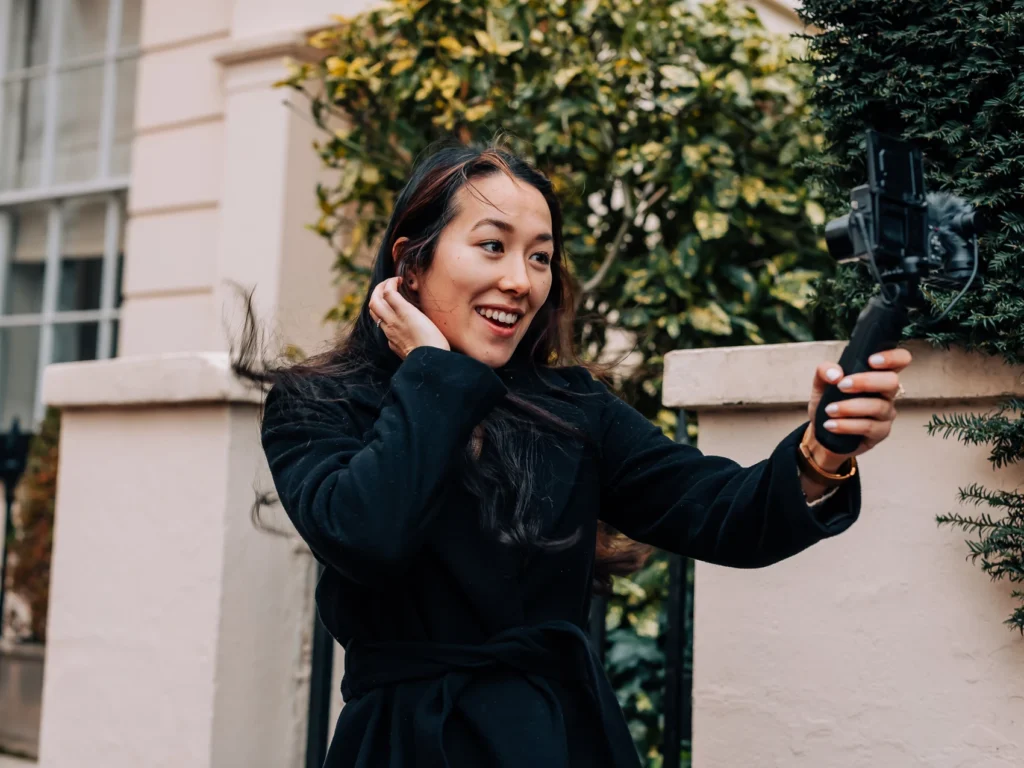Vlogging is fun and rewarding—just follow our vlogging tips and learn how to capture beautiful footage to please savvy viewers.

You’ve found your niche, a beautiful location and an interesting story to vlog about. You may have all of the ingredients for the perfect vlog, but do you know what kit to choose and how to film your video to a high enough standard to please savvy audiences?
In this vlogging how-to, we reveal seven tips for beginners and for vloggers wanting to improve the quality of their videos. Find out how you can capture quality footage that will keep your viewers coming back for more – how to get steady (shake-free) and sharp footage, the importance of creative framing, and what you need to capture crisp and clear sound. Whatever your vlogging camera, whether you’re shooting on a Canon PowerShot G7 X Mark III, a Canon EOS M50 Mark II or a Canon EOS M6 Mark II, here’s what to consider when creating your first vlogs.
1. When choosing kit, balance camera and sensor size
A camera with a larger sensor will give you better quality images, but when you’re vlogging it’s important to balance sensor size with the overall size of the camera. For example, a PowerShot G series camera with a built-in lens, such as the Canon PowerShot G7 X Mark III, is a super compact and portable vlogging camera. However, a mirrorless camera or a DSLR with interchangeable lenses will give you a greater variety of lens options.
Having both a smaller and a larger camera will cover you when shooting for different purposes and will also give you additional camera angles in your vlogs.
2. Use a wide-angle lens
Many vloggers use wide-angle lenses because they can be used in tight spaces such as a bedroom or kitchen to show as much of the scene as possible. A 24mm lens is good for that purpose, but an ultra-wide lens is even better. So if you’re shooting with an APS-C sensor camera such as the Canon EOS M6 Mark II or the Canon EOS M50 Mark II, pairing it with an ultra-wide-angle zoom lens such as the Canon EF-M 11-22mm f/4-5.6 IS STM lens means you can fit more into the frame. For DSLR users, or those using a Canon Mount Adapter EF-EOS M with their mirrorless body, the Canon EF-S 10-18mm f/4.5-5.6 IS STM lens offers similar capabilities.
Whichever lens you decide to use, flip up your camera’s screen to help you position yourself in the frame to make filming selfies and low-angle shooting a breeze. Many cameras, such as the Canon PowerShot G7 X Mark III, can also be connected via Bluetooth to the Canon Camera Connect app on your smart device to film or shoot yourself remotely.
3. Decide your resolution and frame rate
The demand for video is rising, and with it the expectations for quality. However creative your content may be, if the footage lacks detail it’s worth improving. Look for cameras with Full HD or 4K video – Full HD is a good standard to set, but 4K will give you even more detail, allowing you to crop and stabilise your footage without compromising quality. Shooting in 4K doesn’t mean you have to publish in 4K, but remember that 4K footage will take more time to edit and upload.
The most important thing to consider is what frame-rate will suit your subject. 60 frames per second (fps) is best for action vlogs and will give you an option to do slow-motion effects. 30fps or 25fps will be fine for everything else. For even more detailed slow-motion footage, the Canon EOS M6 Mark II and the Canon PowerShot G7 X Mark III offer fast frame rates up to 120fps when shooting in Full HD.
4. Keep your footage steady and in focus
The compact size and light weight of Canon vlogging cameras such as the Canon PowerShot G7 X Mark III, Canon EOS M50 Mark II and Canon EOS M6 Mark II make them ideal for recording movement. A captivating vlog should take the audience on a journey with you – whether it’s through a city’s cobbled streets or showing your reaction to unwrapping your latest purchase – and movement can be key to that. Rather than shaky, distracting footage, make sure your shots are smooth so that viewers can focus on your exciting location or interesting story.
To keep shots steady, support the camera from underneath with the palm of your hand and grip it at the side. If you need extra support, a grip accessory that attaches to the camera body, giving you something to grip on to, can be a useful addition. Good tech also helps a lot: for crisp and steady movies, use a camera that features Image Stabilisation or a lens with Optical IS, which makes your footage clearer and easier to watch, such as the Canon PowerShot G7 X Mark III. The camera’s 5-axis, Dynamic IS is designed to counteract camera shake even when you’re running, panning or shooting at full zoom.
As a vlogger, your face is the thing people will look at, so keeping it in focus is crucial. Canon’s Face Detection and Eye Detection technology can automatically track your face and keep it in focus.
5. Pan with purpose
Moving the camera horizontally during shooting, or ‘panning’, will allow your audience to see through your eyes – to be there with you as you look across a sweeping bay or a skyline filled with eye-catching buildings. Excessive panning can be disorienting, but when done in moderation it can add interest and drive the narrative.
Use panning sparingly, without rushing, and keep horizons level. If you don’t have a tripod, place the camera on something stable – such as the edge of a bench or a table – keep the camera in the same place and move it steadily, with purpose, to the side.
6. Plug in an external mic for better sound quality
Most cameras that shoot video will offer acceptable sound quality, but if excellent sound is important to your vlogging, consider plugging in an external microphone. An external mic is particularly useful when you’re working outside, because the camera’s built-in mic is likely to record distracting background noise such as wind, whereas you can reposition external mics to help block this out. If you want to use an external mic, look for a camera with an external mic socket, such as the Canon EOS M50 Mark II or Canon PowerShot G7 X Mark III.
7. Use Wi-Fi for sharing
Many cameras on the market today, including the Canon EOS M50 Mark II and the Canon EOS M6 Mark II, provide integrated Wi-Fi and Bluetooth, giving you the ability to share and back up wirelessly wherever you are in the world. Cameras such as the Canon PowerShot G7 X Mark II (now succeeded by the Canon PowerShot G7 X Mark III) even feature a Wi-Fi button, making saving and sharing simpler than ever before.
The Canon PowerShot G7 X Mark III has Bluetooth and Wi-Fi for an always-on link with your smart device – plus, connect via Wi-Fi to your smart device or network with internet access and you can Live Stream to your YouTube1 channel.
To Discover More about
DSLR or Mirrorless click here
Batteries for Canon Camera click here
Canon for Beginners click here
Camera Accessories click here
Top 7 Canon Camera click here

